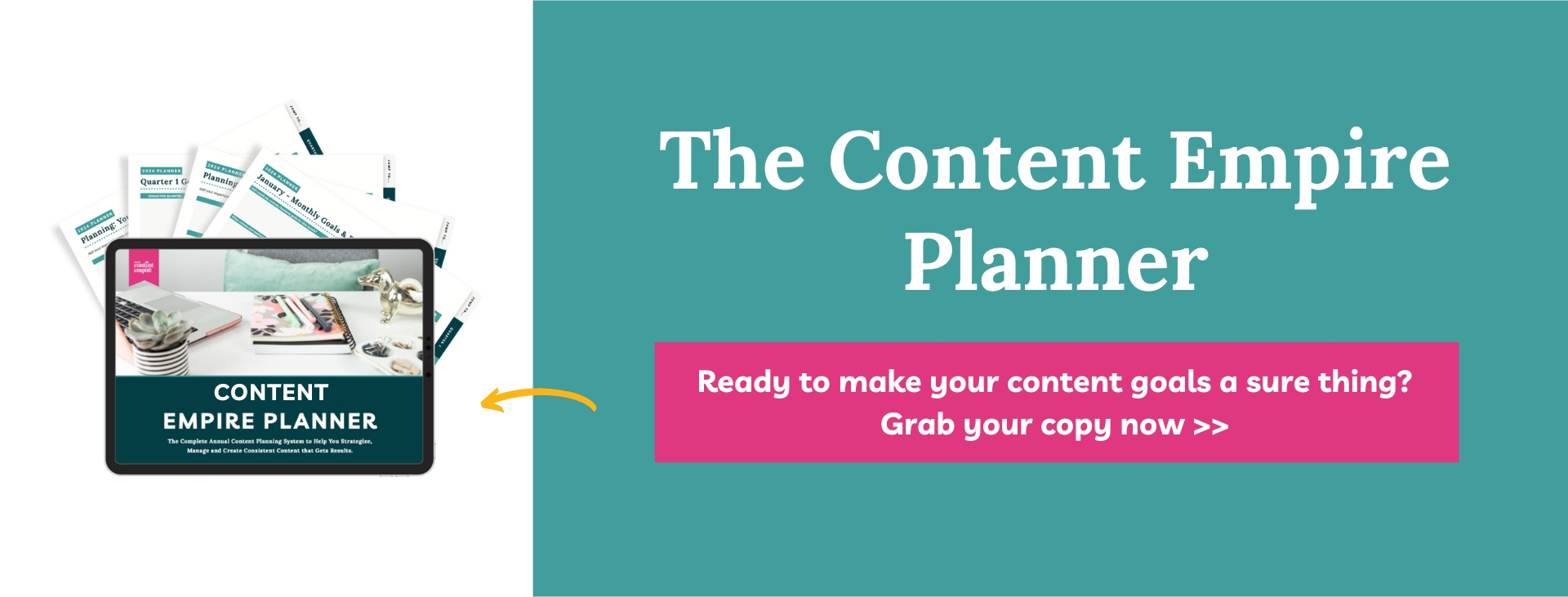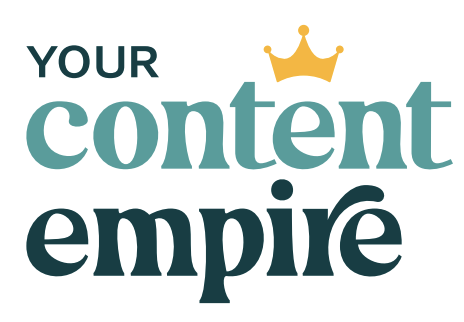Every year in November, I go away for a few days for an annual content planning retreat to reflect on the past year and plan for the coming one.
Some years, I book a hotel room with an ocean view for two nights, have room service on stand-by, and paint the walls with post-its. Other years, it’s an AirB&B on a nearby island and my husband tags along for hike breaks, his own deep work, and date nights to cap off each day.
Or it can even be as simple as prepping a staycation at home, migrating my computer and planning supplies to the dining room table for a change of scenery.
The point is: getting out of my regular space is essential. It’s easier to think in a big-picture way when you’re not distracted by the small, day-to-day stuff!
This year I’m inviting you to come along by using this post as a follow-along agenda for your own planning retreat (or grabbing my Annual Content Empire Planner with DIY workshops built-in!)
Here’s your Day 1 Annual Planning Retreat Agenda:
Step 1 – Measure What Happened Last Year
I don’t know about you, but for me it’s just way too easy to misremember things, both good and bad, unless we take contemporaneous measurements and notes like what worked well in a launch campaign, what topics our community liked the most, or what newsletters were responded to the most.
That’s why it’s important to look at the numbers before going into creating a content strategy for the new year. Last year, I said this was the boring part (and collecting it still is), but I’ve managed to collect most of it while I go week by week so it’s simply a matter of exporting reports at this point.
But if you haven’t had this set up I’ve still got you covered, and maybe while you’re at it, you can set up some systems to do this in a more automated, streamlined way next year to save yourself some of the headache #LookingAhead
Here's my process:
- Gather my tools and records: monthly measurement sheets, yearly marketing summary sheet (mine is from the planner)
- Open my marketing tools: Google analytics, social media account analytics, email marketing account, LeadPages
What I’m looking for:
- Website analytics: Total and unique visitors, bounce rate, and time spent on site.
- Blog analytics: What were my top 10 posts this year? Any trends?
- Freebie analytics: How many people signed up for each? What was the conversion rate for each? Any trends?
- Email analytics: Average open rate? Average click-through rate? Email subscribers? Unsubscribes? Growth per month? 10 most opened emails? 10 most clicked emails? Any trends?
- Social media posts (by platform): Followers? Growth? Click-throughs? Click-through rate? 10 most popular posts? Any trends?
- Paid advertising: Amount spent? Amount earned? Profit? Cost per lead? Cost per customer?
- Offers: # sales per offer? $ Sales per offer? Cost of delivery per offer? Cost of customer acquisition (if this is possible to find – not always for every offer)? Methods of finding customers for each offer?
- Funnel: # leads entering? # leads purchasing? Email performance (click throughs and opens)? Earnings per lead? Any trends? Changes to be made?
What I’m looking for – monthly numbers:
For each month I look at:
- Marketing results
- Offer results
- Trends
- What was happening in my business at the time?
- Takeaways – What worked? What didn't? Other observations?
Then I summarize:
- What is a must for next year?
- What should be tweaked for next year?
- What have I learned about my marketing?
- What have I learned about my offers?
- What have I learned about my customers?
- What have I learned about my business and myself as an entrepreneur?
Take Action on Step 1:
- What are your numbers so far this year? Gather and summarize them using a Google sheet or the Content Empire Planning Bundle.
- What are your highlights for each month of the year? This is one of my favourite records to keep and look back on!
Step 2 – Dream Up Some Inspiring Goals
After being hit over the head with the reality of the year nearly behind me (just kidding, I always manage to see the wins even if I missed the mark on a few fronts), I like to put my head in the clouds and dream up some dreamy goals to set the course for my coming year.
And so I always kick my strategy process off with goal setting. After all, it’s impossible to get to where you want to go if you haven’t decided on a clear destination.
So start with a little dream sesh about all the things that are possible. Then get to the focused part of choosing which ones you really want to go after.
There are two types of goals you can set: Achievement goals and Project goals.
Achievement goals are those that usually have a number attached to them and aren't completely within your control.
For example, I will hit $XXXX in sales this quarter or attract XXX new subscribers. Or I will win X award or get published on X website.
These are the types of goals where you could do everything right and still not achieve them. They're exciting and a necessary (albeit scary) part of any business strategy.
I've always tended to shy away from these in my own business. I don't like being unable to guarantee the successful outcome of something I invest so much of myself into.
I've been working on easing into to achievement goals with help of a few tips:
- Set good/better/best versions of your goal.
It doesn't feel awesome to put yourself out there and come up short. So create a buffer by setting three number variations of your goal. A good version of the goal that'll be easy to reach. A better version of the goal which is a bit of stretch. And the best version of the goal that'll have you over-the-moon, popping-corks kinda happy.
That way even if you hit your good goal, you've succeeded and can readjust for the next round.
- Detach from the outcome.
Set the number goal but don't get attached to it. It's almost like once you've set it, you release it and just focus on the process. Work your plan, measure at regular intervals, and adjust. No matter what happens, you've moved the needle on getting closer to your goal.
- Visually create space for your goals.
I first heard of this strategy from Being Boss and their Chalkboard Method. When you set an achievement based goal with a number attached to it, create a visual representation of it that you can use to track it and act as if it's already come true.
There's a couple of different applications of this.
- If you want to get 4 new coaching clients: On a chalkboard, whiteboard or even a piece of paper on your desk, have the goal written out and create 4 blank spaces to write in your client's names once you've landed them. And here's my favourite way to use it. Say these clients each get a 1-hour session a week. Go ahead and pre-block the time on your calendar. Until those sessions are booked, you use this time on your calendar to find that client. Then until they've actually filled the spot, you're dedicating yourself to them already for that hour.
- If you want to reach 500 subscribers: Colour your way to them! Get a colouring goal tracking sheet (option 1 or option 2) and for each subscriber you get, colour in one of the spaces. Keep it somewhere visible to motivate you and remind you of what you're working towards.
Project goals are my happy place. These are the goals that are more so within your control whether they get finished or not. They also have a definite end point – they're either done or they're not.
For example: Launch my new website, create a new program, and launch my new course.
These types of goals are both liberating and limiting.
Liberating because when you commit to making them your focus, you'll feel unstoppable in accomplishing them. The benefits you achieve because of project goals (sales, subscribers, etc.) are side effects – cherries on top of the main event.
Limiting because after completing a few project goals, you'll realize that the numbers that you achieved as a side effect of the projects could be much higher if you were intentionally focused on reaching them. It's both a blessing and curse to be free of chasing after such things.
So the solution? Set a mix of achievement and project goals. Also, focus on choosing project goals based on their positive relationship to the outcome of your achievement goals.
Want to learn about setting breakthrough content goals you'll actually reach? Read How to Set Breakthrough Content Marketing Goals You’ll Actually Reach.
Take Action on Step 2:
- Do an unfiltered dream storm of everything you want to do the next year.
- Narrow it down and choose which goals you want to actually pursue.
- Bonus points – Choose 1-2 words to guide your year too.
Step 3 – Add the Big Rocks to Your Calendar First!
After you’ve got your goals in place, it's time to look at the year and put in the “big rocks.” These are the events happening this year in your business and personal life.
Even if the dates are still loose at this point, having these marked down will help you create a content strategy that’s realistic and supports your schedule.
For example: I know I’m traveling a ton in June, so I likely won’t be planning a launch and other big projects for the same month.
So in a yearly calendar or even just in the doc that you’re using to capture your plan, mark down the big stuff. Think launches, vacations, events, conferences, holidays, projects, etc.
Take Action on Step 3:
Create your cornerstone calendar for the upcoming year
Step 4 – Your Annual Audience Tune-Up
Even though you’ve probably lost count of the times you’ve done the ideal customer avatar exercise (or one of the other countless names it’s called), I do think it’s good to revisit it at the start of each New Year.
But I like to put a little spin on it by turning it into a client journey map.
Because while ideal client avatar exercises definitely have their time and place, I believe that for our purposes there’s a better use of our time than speculating that our dream clients drive a red car and eat chocolate for dinner (unless you’re selling dinner chocolate, in which case, hook me up).
The client-to-reader journey map tracks their typical journey with you from the time they first started working with you or following you to when they’re ready for the next thing, and it even helps you identify what that next thing is. It also pairs your content and offers to their struggles at any particular time.
You can use this to identify gaps in your offer suite or marketing and use their lingo to describe their problems, desires, and knowledge of your industry in a way that resonates. Read more about this in my post about How to Create an Offer Docket to Position Your Offers.
Your knowledge and understanding of your customer will change and deepen considerably over the course of the year, so your offers and focus may have changed too.
Take this opportunity to revisit who that customer of the client is and what problems you’re solving for her.
- My ideal customer persona – She's got a name, a life, and hobbies. She's struggling with very particular things. And even though she's an amalgamation of a bunch of my favourite clients and students (and even myself at earlier stages in my business), and I know that I'll never get a client who's an exact match. But having her in front of me when I'm creating content makes it easy to come up with the right words because every piece of content I create is just a conversation I'm having with her.
- My ideal client swipe copy bank – Want a new marketing superpower in your business? Start to keep a swipe copy bank from your favourite clients or dream clients. Anytime they open their mouth or hit the strokes of a keyboard to describe their biggest challenges, questions, and frustrations about your area of expertise? LISTEN UP and capture all of it someplace. Then when you're writing a sales email or a blog post, you can put those things in her words and directly respond to how she's feeling. If you're anything like me, you have a tendency to geek out hard over your industry and the business jargon starts to feel natural, even though speaking to our clients in this language would lead to glazed-over eyes.
- My customer journey maps – Your offers may have changed, and the path that your clients take to get to your offers may have changed too. Revisit this regularly to make sure you're not missing any pieces in the journey. Think: Attraction Content (how they discover you in the first place) > Retention Content (what you use to get them to sign up for your freebie or newsletter) > Validation Content (VIP or exclusive content you use to woo and engage them turning them into full-fledged + enthusiastic members of your community) > Conversion Content (the content you use to promote your paid offers). Read more about these 4 types of content here.
Take Action on Step 4
Revisit your Ideal Customer Avatar and turn it into a client (customer) journey map
You’re Almost Retreat Ready!
You’re halfway through everything you’ll need to get done on your annual content planning retreat which includes measuring and analyzing the last year, dreaming up bigger and better goals, adding the big rocks to your calendar, and your audience tune-up.
Don’t forget to grab the Content Empire Planner so you can strategize, manage, and create consistent content that gets results.














